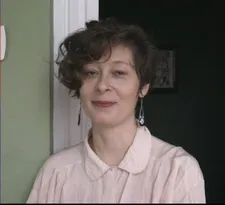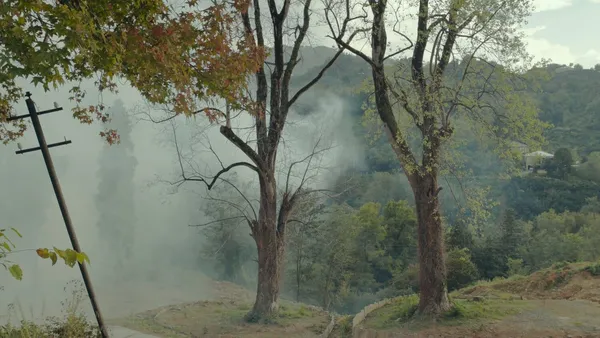 |
| Taming The Garden Photo: Courtesy of Sundance Institute |
In a film that is packed with striking images, the sight of fully grown tree being transport across a vast expanse of water by ship in Salomé Jashi’s Taming The Garden is probably the strangest. A thing of beauty, at once natural and majestic yet there’s also something tragic about it being cut adrift from its natural landscape.
When I catch up with Jashi over Zoom, almost a year after her film premiered at Sundance Film Festival, she says: “This mix of emotions was something that made me want to make this film. It was not just the story, which is a big story by itself, but rather the feeling that this story, this image, this primary image of the tree is evoked inside of me. For me, it was like this glitch, as with an old VHS or mini DV tapes, when you see something that was not supposed to be there, this idea of glitch and error, of beauty and ugliness at the same time, this mixture of so many ideas that were coming into my mind were most attractive.”
The reason for the tree’s transportation is – although he is not specifically named in the film – down to the desires of a single man, Georgia’s billionaire former prime minister Bidzina Ivanishvili. He has created a dendrological park from mature trees uprooted and gathered from across the country. The tree on the ship put me in mind of the nihilist penguin in Werner Herzog’s Encounters At The End Of The World, which is seen heading towards the mountains instead of the sea.
Jashi’s film captures the real tension between the tree and the surreal situation it is placed in. I wondered if her emotional viewpoint shifted through the course of making the film, which sees her travelling the country to capture on camera the often surprising reactions of communities who have agreed to let their trees go to a new home.
 |
| Salomé Jashi: 'A shot needed to have a second or third layer to it, it needed to represent something that goes beyond the actual visual narrative' Photo: Courtesy of Sundance Institute |
“Certain things shifted, of course,” says Jashi. “I think the initial feeling stayed there. And I tried to use this feeling as we were working on the film. You know, when you see a tree move over such a long time, then it's not surprising any more, it becomes a very banal image. So sometimes I would ask, ‘Maybe it's okay, what they're doing. Maybe there's nothing special about it?’ And then we'll see place where there was a tree. And we would ask like, ‘Do you or do you miss a tree there? And does it make a difference if a tree is there or not? What if there was no tree before that?’ You start to doubt your critical opinions that you had from the beginning. And that's when I would go to these very first, striking emotions. But one thing that I would refer to, was when we, for the very first time, filmed a tree move, I felt dizzy, I felt sick, like on a roller coaster, like what when your axis shifts totally and you lose your ground. And I think this losing ground was something that we wanted to have as part of the film.”
The idea of something incredible being normalised is interesting in itself – both in the sense of money being able to buy anything and in the idea that, if a powerful person does something frequently, people can become accustomed to it even if it’s completely weird.
“I think in the contemporary world, where we live, there is a lot of injustice, a spectrum of injustice, but we have become super-used to it,” says Jashi, “And in developed countries, the way we deal with it, maybe we transfer 10 to 100 pounds to charity, and we think that maybe this will fix the problem – and it takes 10 seconds to do it. And 10 seconds in our brains, our hearts. And some other things we are so used to we don't even pay attention to, like inequality. So, with these trees, at some point we were questioning, maybe it's normal.”
Trees are a touchstone for many cultures and the idea of a ‘family tree’ takes a different shape here, as we see people who are about to wave goodbye to them often suddenly realising how deeply they feel about them in the first place.
“It’s really much buried. In some cases, I spent a lot of time with these people. I knew what to expect more or less. But in some cases it was rather a revelation, it was a discovery. Like when the family react near the end the of the film, I did not anticipate it because they and especially the woman were never really expressive about their feelings. So it took us by surprise. It took us by surprise that the whole village started to follow the tree and I think they themselves did not plan it, it was very instinctive. It's like when, when a dead person is taken to a cemetery in a village, the whole village follows it. And it's kind of normal, natural, instinctive acts. And that's how it happened here as well.”
There’s a noticeable difference in the way men and women react to the trees’ departure as well, something that runs culturally deep.
Jashi says: “Men were really like serving the desire of the rich man, they were implementing orders. But also, not only kind of being subordinate to the hierarchy, but also they were more responsible for, for being presented well, in front of those in power. Women have, in a way, more freedom, because women here are considered more irresponsible, like less taken seriously. I think this cultural prejudice gives them some kind of freedom – not being responsible for what they say in the eyes of those in power.”
 |
| Taming The Garden Photo: Dogwoof |
The surreal nature of what is being captured is enhanced by the way Jashi gives the film a fairy tale and mythic quality, a sense of things being corrupted by this movement, as when neighbouring trees are damaged in order to lift one.
Jashi says this is something she had in mind “both when we filed and when we were editing,”
She adds: “What was really important for me during both stages was that a shot would not be enough if it only showed a specific action. A shot needed to have a second or third layer to it, it needed to represent something that goes beyond the actual visual narrative. And that's how we kind of constructed this. This mythical fertile kind of growth was also very intentional”
Jashi says she wanted to start the film from the point where a tree was already on the move. She explains: “So we are not in the real world any more. We're already in another world where a tree moves where the axis has shifted, where, where everything can be possible, where something else happens that is not part of the contemporary world right now. With this approach, we try to build this fairy-tale kind of narrative.”
These ideas, along with the tension between the natural and the unnatural are further fuelled by the sound design from Philippe Ciompi and scoring by Celia Stroom.
“The film is teamwork,” says Jashi “And huge credit goes to several people who contribute to the front a lot, including the researcher Tamara Mshvenieradze, who did a fantastic job. And we also worked a lot with the sound with the editor Chris Wright, he predesigned certain scenes, and then Philippe Ciompi did a fantastic job to enrich the soundscape not just to enrich, but also to create this atmosphere of where we are. It is in a way an enhancement of the visible, but also the showing of the invisible. With the music, Celia came to us while we were filming and she knows Georgian culture very well. And what she observed from the very first time she came to film with us was that she said that the machines represent for her atonal music, and that's how I think the first choice of Stockhausen came, because of the completeness of the atonal music composition. And then towards the end of the film and the final scene, we wanted to subvert the narrative and kind of show a celebration of this garden. I also wanted the music to match this tone of fireworks of celebration. The magnificence in a way but in a grotesque manner as well. And that's when she came up with this French mediaeval composition, which is actually called in English, The Sound Of Birds, but she re-edited it to fit the scene. There’s an artificial sound of birds, which is added to the natural sound of birds, which most people don't notice, obviously, when you would know it's artificial, but it emphasises this atmosphere of artificiality.”
Although Jashi is working on other film ideas, there’s another cinema project she’s throwing her energies into – and that is bringing smaller films to a wider audience in Georgia. “I started to I became kind of enchanted by this idea to start building up a place that I cultural place where people can go and watch independent films,” she says, adding that she is working on the idea of collaborating in existing spaces to bring better access to less ‘commercial’ films.
“Sometimes it's good to do something a little bit different. And I think it's good to do something that is useful for somebody.”
As a documentary, Taming The Garden is most certainly a little bit different, and you can catch it in UK cinemas and on demand from Friday, January 28.





















